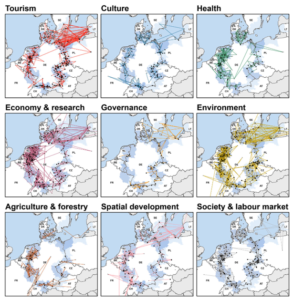Institutional mapping combines institutional information and visualisation techniques. Our team has worked with this approach for several years now (e.g. ESPON ACTAREA 2017, Chilla et al. 2012).
Now we published a new paper that a) describes the state of art in institutional mapping and b) does so with the example of German INTERREG VA programmes.
For this paper, we use the open access EU KEEP database (www.keep.eu) to gather spatial information about funded project cooperation, the involved thematic topics and the role of territorial contexts. Additionally, we consider the capacity of institutional mapping of KEEP data by discussing potential and limitations. We conclude that institutional mapping of INTERREG A funding and projects has clear restraints to causality but benefits from a huge data exploration capacity.


